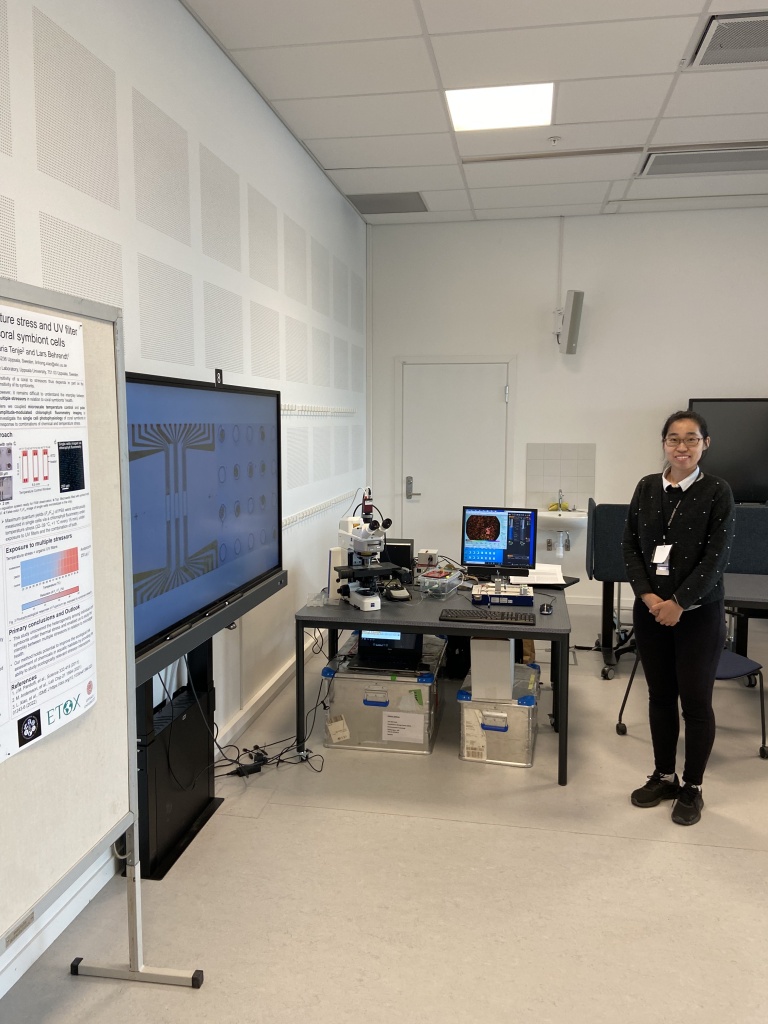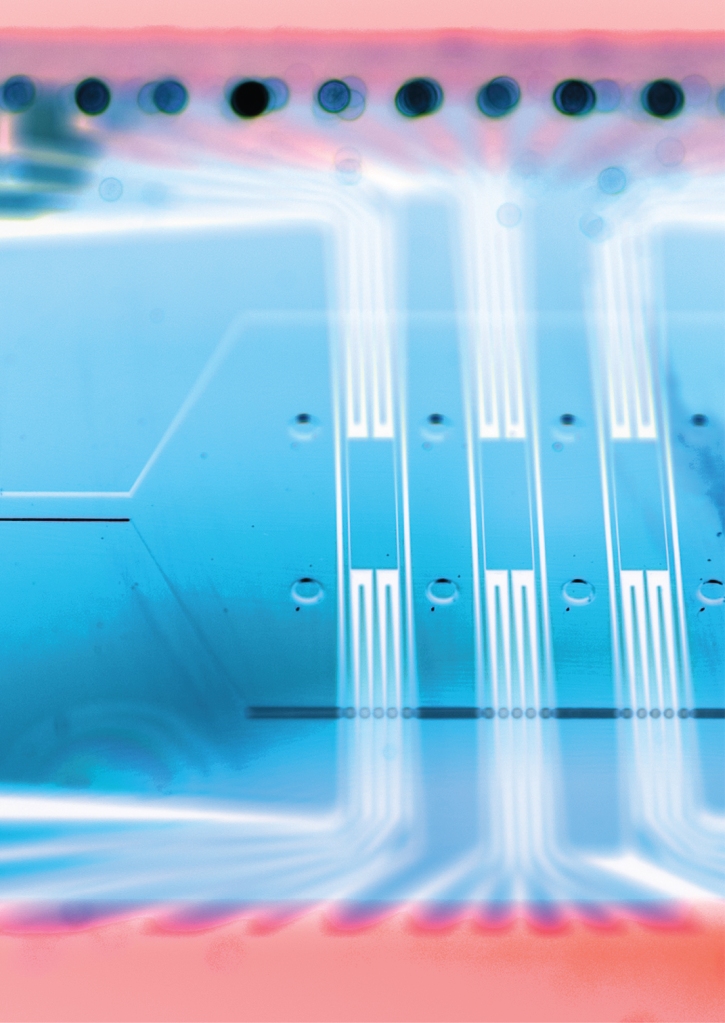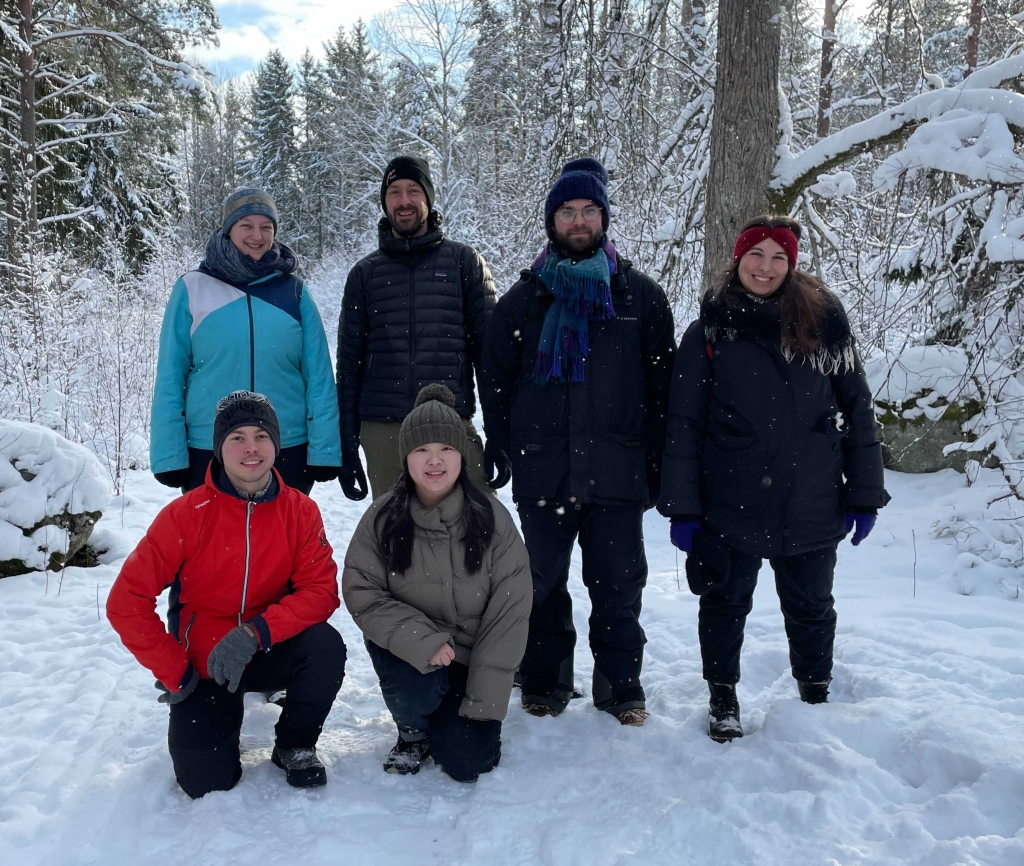
News from the Behrendt Lab
1st of November 2023
Two new master students at the Behrendt Lab:
Saman Ghodsi

In his master thesis, Saman is investigating the metabolic and inflammatory distinctions between human and mouse immune cells to identify potential evolutionary divergences. Specifically, he is examining the oxygen respiration patterns of macrophages and T cells in response to Lipopolysaccharide (LPS), known to trigger inflammatory responses. To measure their oxygen consumption, he employs O2-sensing chemical probes, enabling the spatial mapping of their oxygen respiration in reaction to bacterial stimuli.
Weclome Saman!
Michael Kinsella

In his master thesis, Michael will analyse imaging data to understand Symbiodiniaceae’s morphology and life cycle. The project will involve cell segmentation, lineage tracing, and the possible development of a deep learning model. The aim of the thesis is to develop an opensource workflow to aid in future studies of Symbiodiniaceae
——————————————————————
20th of October 2023
New paper out in Cytometry Part A
(Olle first author, Yuan and Linhong co-authors, Lars last-author)
https://doi.org/10.1016/j.crmeth.2022.100216
Here we are introducing PACMan, an open-source software elevating MICROSCOPY-PAM system efficiency by 10-fold. Explore this special paper on a novel technology for high-throughput microalgae phenotyping. Special thanks to Olle Pontén, a previous master student of my lab for his tireless efforts in getting this paper assembled!
——————————————————————
31st of March 2023
Congratulations to Alexander and Samuel for finalizing their Master thesis!
Samuel and Alexander have both excelled in conducting their master thesis research and presenting their findings both in written and oral form. Samuel’s developed image analysis pipeline is set to become an invaluable resource for our lab’s future research endeavors. Likewise, Alexander’s work on correlative measurements, which utilized secondary-ion mass spectrometry and chlorophyll fluorometry, has established an indispensable tool that will greatly aid our lab’s research efforts
You will both be missed!
——————————————————————————————————————————————-
6th of December 2022
Lars awarded ‘Best Pitch Award’ by Uppsala Innovation Center (UIC)
Lars successfully completed the UIC startup school with his innovative startup concept ‘Cellect’, winning the ‘Best Pitch Award’ in the final pitching round. Congratulations!
——————————————————————————————————————————————-
1st of September 2022
Two new master students at the Behrendt Lab:
Alexander Wood

In his master thesis, Alex is describing the photosynthetic functioning and carbon uptake of the coral symbiont, Symbiodinaecea under exposure to UV-protective chemicals. The two main methods that Alex uses are Pulse-amplitude-modulated chlorophyll fluorometry (PAM), to measure the photosynthesis, and Secondary Ion Mass Spectrometry (SIMS) to measure the carbon uptake. The aim of Alex thesis is to perform both types of measurements in a correlative fashion
Weclome Alexander!
Samuel Zargani

In his master thesis, Samuel will develop an automated image analysis platform that can convert interferometric images obtained from an automated imaging platform in order to quantify the changes in dry-mass of individual of bacterial cells for multiple positions, over time.
Excited to have you onboard Samuel!
——————————————————————————————————————————————-
27th of July 2022
Opinion paper out in Environmental Science & Technology
(Linhong first author, Lars last-author)
https://doi.org/10.1021/acs.est.2c02961
Brief summary: In this collaborative paper we discuss whether the timing between externally mediated physiological rhythms and chemical exposure should be included into the study of environmental toxicology. To advocate for this, we describe two biological systems where physiological rhythms play a fundamental role, but where we only have a limited understanding about how the timing of chemical exposures might affect physiological outcomes.

Besides Linhong and Lars, this work was done in close collaboration with Joëlle Rüegg (Uppsala University, Sweden) and Philipp Antczak at the Center for Molecular Medicince Cologne (University of Cologne, Germany).
——————————————————————————————————————————————-
26th of May 2022
New paper out in Cell Reports Methods
(Yuan first author, Lars last-author)
https://doi.org/10.1016/j.crmeth.2022.100216
Brief summary: In aquatic environments, O2 production and consumption are intimately connected via transport processes. Many organisms generate flow fields to enhance exchange-processes and optimize their metabolism, yet our understanding on these complex interactions is mostly derived from mathematical models. This is primarily because we lack high-resolution methods that can accurately measure transport processes and O2 levels at the same time. To address this problem, we developed ‘sensPIV’ a simple, inexpensive, yet powerful method that uses chemically sensing microparticles to quantitatively link O2 distributions to physical transport processes. SensPIV can now be used to study flow-organism interactions across many life-science and engineering applications.

This work was done in close collaboration with Klaus Koren (Aarhus University, Denmark) and Soeren Ahmerkamp at the Max Planck Institute for Marine Microbiology (Bremen, Germany).
Featured by Eureka Alert, Uppsala University, Max-Planck Institute for Marine Microbiology, Deutsche Allianz Meeresforschung, Aus Der Welt and SciLifeLab.
——————————————————————————————————————————————-
20th of May 2022
Presenting our research at the Angstrom Climate Change day
Linhong in front of our experimental setup! Good discussions with good people at a nice event (more info here).

——————————————————————————————————————————————
26th of April 2022
New paper out in ISME J
(Linhong first author, Saskia co-author, Lars last-author)
https://www.nature.com/articles/s41396-022-01243-6
Brief summary: In this study we investigated how different species of coral symbionts react to temperature stress. In contrast to previous studies, we used a unique miniaturised approach consisting of a microscope and a credit card-sized ‘microchip’ that houses many hundreds of individual coral symbiont cells to assess differences in temperature sensitivity among single cells. Through this unique approach, we were able to determine that individual cells within each species behave quite differently from their sister cells and use the resulting data to predict the thermal sensitivity of populations of single cells.
Featured by Uppsala University and SciLifeLab. Further, a behind the paper summary by Linhong. This paper was highlighted as a key publication in this issue under ‘Editors’ Choice‘
——————————————————————————————————————————————-
27th of January 2022
New paper in Marine Drugs
(Lars being last-author)
https://pubs.acs.org/doi/full/10.1021/acs.est.1c02836
Brief summary: In this review, we discuss the possible functions of Patellamides, bioactive cyclic peptides that are produced by the photosymbiotic cyanobacterium Prochloron. We speculate that, when associated with copper (II), patellamides exhibit an array of in vitro functions, including that of an anhydrase, phosphatase, lactamase or glycosidase and that this activity spectrum is linked to the rapidly changing microenvironment in the animal host of Prochloron. This work was done in collaboration with the Microenvironmental Ecology Group at Copenhagen University and the Comba group at Heidelberg University.
——————————————————————————————————————————————-
1’st of November 2021
New paper in Environmental Science and Technology
(Lars being co-author)
https://pubs.acs.org/doi/full/10.1021/acs.est.1c02836
Brief summary: In this study we developed and applied a high-performance liquid-chromatography lipidomic method and used in to investigate the lipidome of two types of sinking particles─marine snow and fecal pellets. We further pressed the limit of this approach and examined the lipidomic heterogeneity among individual diatom cells from a single culture. These data confirmed that even cultures of phytoplankton cells should be viewed as mixtures of physiologically distinct populations.

——————————————————————————————————————————————-
23’rd of September 2021
New paper in Nature Geosciences
(Lars being co-author)
https://www.nature.com/articles/s41561-021-00817-x
Brief summary: Here we show that the sinking speed of marine particles determines the rate at which bacteria degrade them. The molecular mechanism underlying this sinking-enhanced degradation is the flow-induced removal from the particles of the oligomeric breakdown products, which otherwise compete for enzymatic activity. This paper proposes that the coupling of sinking and degradation contributes to determine the magnitude of the vertical oceanic carbon flux.
Featured in ETH news (here) and World Economic Forum (here)
——————————————————————————————————————————————-
1’st of June 2021
Lars accepted as docent in Environmental Toxicology
After giving his lecture on ‘The effects of multiple stressors on phytoplankton cells‘ Lars got awarded Swedish docentship. For those who interested what a ‘docent’ is see here.
——————————————————————————————————————————————
12’th of May 2021
Lab get-together
Fika at the Behrendt lab followed by a picture!

——————————————————————————————————————————————
22’nd of March 2021
New paper in Lab on a Chip!
(Linhong being co-author, Lars being co-corresponding)
https://pubs.rsc.org/en/content/articlepdf/2021/lc/d0lc01288b

Brief summary: In this collaborative paper between members of the Tenje Lab and the Behrendt lab a microscale heating system was constructed and used to test the thermal tolerance of Symbiodinium cells.
The heating system is unique in that microfluidic devices of different geometries can be used and rapidly interchanged. More cool stuff to come out from this effort!
Bonus: we got featured on the back cover art! (left)
——————————————————————————————————————————————-
13’th of March 2021
Olle awarded a grant by the Swedish Phytogeographical Society!
Olle received this grant to cover travel costs associated with a collaborative project and that willl focus on the photophysiological effects of environmental stressors on algae. The amount awarded was 50 000 SEK.
Massive congrats to Olle!
——————————————————————————————————————————————-
11’th of February 2021
A wonderful (and freezing) lab excursion
The Behrendt Lab went on its first social outing after COVID. Fully immersed in the Swedish outdoors we enjoyed food, drink and each others company. Many more to come!

- Bottom left: Emanuel, Yuan
- Top left: Saskia, Lars, Olle, Chiara
——————————————————————————————————————————————-
25’th of January 2021
New paper in PNAS
(Lars being co-author)
https://www.pnas.org/content/118/5/e2005944118.short
Brief summary: This paper describes the behavioral and physiological effects of ocean turbulence on motile phytoplankton. As motile phytoplankton apparently sense the intensity of turbulence they can then use stress signaling to trigger switches in their migratory behavior. These effects might ultimately govern which species will be successful in a changing ocean
——————————————————————————————————————————————-
17’th of January 2021
Second newest member of the Behrendt Lab: Saskia Rughöft
Saskia is microbial ecologist, who will combine microfluidic technologies and quantitative phase imaging, to develop a novel high-throughput ‘Ecotoxicology-on-a-chip’ approach. She joined directy after finishing her PhD in Tübingen
Welcome to the lab, Saskia!
——————————————————————————————————————————————-
17’th of January 2021
Newest member of the Behrendt Lab: Olle Pontén
In his master thesis, Olle will develop software to automate photophysiological measurements via our in-house chlorophyll fluorometry system. Olle will apply this novel software tool to screen populations of single cell autotrophs for their metabolic heterogeneity. Once implemented, this will truly make our methods ‘high-throughput’.
Excited to have you here Olle!
———————————————————————————————————————————————
11’th December 2020
Exciting new paper in Nature protocols
(Lars being co-author)
https://www.nature.com/articles/s41596-020-00427-8
Brief summary: This paper describes the necessary steps to perform ‘RACS’: Raman activated cell sorting. By incubating microorganisms with stable isotopes RACS can sort cells based on their metabolic activity via a specialized microfluidic platform. For more in-depth information read the commentary here.
——————————————————————————————————————————————-
2’nd November 2020
Newest member of the Behrendt Lab: Chiara Buonfrate
In her master thesis, Chiara will assess the effects of chemicals on single cells of phytoplankton. To do this she will use advanced hydrogel microfluidic devices and combine this with high-throughput automated microscopy to assess the heterogeneity among cells. Excited to see first results come in soon!
Welcome Chiara!
———————————————————————————————————————————————
6’th October 2020
PhD and Postdoctoral opportunities through the Centre for Digital Life, Norway
Are you working or studying at the Centre for Digital Life in Norway? If so, there is now a fantastic opportunity to apply for a 3-year project to join my (SciLifeLab-associated) group.
Work in my lab is centered around the data driven investigation of pollutant effects under recreated and natural scenarios and thus aligns well with SciLifeLab’s long-term strategy on data driven science. A good candidate should have interest in one, or more, of the following topics: microfluidics, image analysis, machine learning, microalgal phenotyping and/or multiple stress theory.
Interested? If so, read more about the application procedure and matchmaking process here: https://digitallifenorway.org/gb/news/join-matchmaking-for-mobility-grant
Looking forward to hearing from you and to meet you at the matchmaking event on the 21’st of October!
——————————————————————————————————————————————-
2’nd September 2020
PhenoChip manuscript finally out!
https://advances.sciencemag.org/content/6/36/eabb2754
Brief summary: PhenoChip enables the observation and selection of single microalgae cells based on their phenotype. A useful tool for ecosystem restoration (full story here) and ecotoxicology!
——————————————————————————————————————————————-
11’th June 2020
Two year postdoc position in ‘Ectoxicology-on-a-chip’
https://uu.se/en/about-uu/join-us/details/?positionId=337983
Excited to receiving your excellent application and welcoming you soon in Uppsala! Questions? Send an e-mail to lars.behrendt@scilifelab.uu.se
———————————————————————————————————————————————
1’st May 2020
Newest member of the Behrendt Lab: Yuan Cui
Yuan joined the Behrendt lab in May 2020. In her project, Yuan will develop a microfluidic platform to measure the metabolism in single marine phytoplankton cells. The platform will form a core pillar of her PhD work in assessing the environmental impacts on cells with a focus on heterogeneity within populations.
Welcome Yuan!
———————————————————————————————————————————————
1’st March 2020
Newest member of the Behrendt Lab: Linhong Xiao
Linhong joined the Behrendt lab in March 2020. In her project, Linhong will investigate combined temperature and pollutant effects on important phytoplankton species.
Welcome Linhong!
———————————————————————————————————————————————
10’th October 2019
VR-grant awarded
We are thankful for the generous support of the Swedish research council for establishing ‘Ecotoxicology-on-a-chip’ technologies